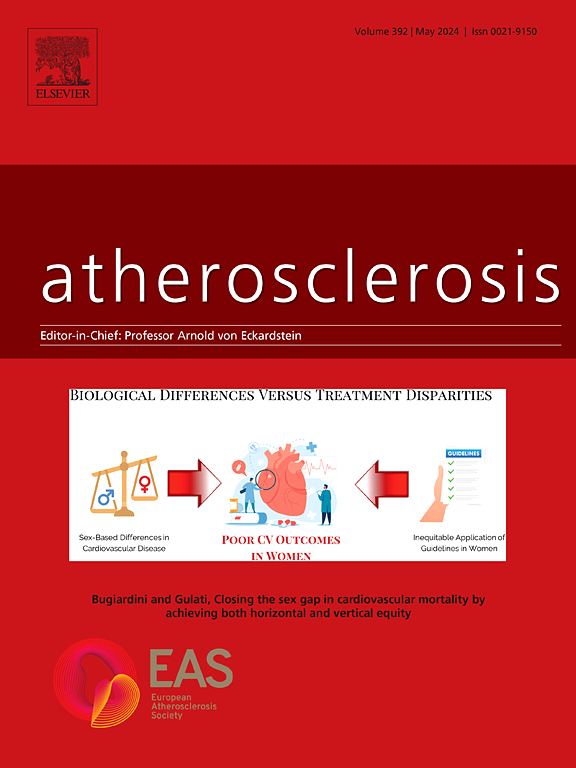Clinical implications of calcification severity adjacent to calcified nodule: Its association with first and recurrent risks of target lesion revascularization after percutaneous coronary intervention
IF 4.9
2区 医学
Q1 CARDIAC & CARDIOVASCULAR SYSTEMS
引用次数: 0
Abstract
Background and aims
Calcified nodule (CN) is a plaque phenotype characterized by protruding calcification, associated with repeat revascularization after percutaneous coronary intervention (PCI). The severity of calcification increases the risk of future target lesion revascularization (TLR). This study was conducted to determine whether calcification severity in the adjacent zone is associated with TLR.
Methods
We analyzed 204 patients who received PCI for de-novo CN using intravascular ultrasound (IVUS). The calcium volume index (CVI) was calculated for each 1-mm cross-sectional frame in both the CN and adjacent zones.
Results
TLR occurred in 63 patients (30.9 %) during a median follow-up period of 2.8 years (interquartile range, 2.4–3.2). CVIs in both the CN and adjacent zones, along with minimum lumen area (MLA) after PCI, were significant predictors of TLR. The ROC curve-derived values for the CVIs in the CN and adjacent zones (10.52 and 5.33, respectively) and the MLA after PCI (6.65 mm2) were associated with higher TLR incidence. Among those requiring TLR, 27.0 % experienced multiple TLRs, with higher CVIs associated with recurrence. In a multi-state model, CVIs in both the CN and adjacent zones were significantly associated with the first TLR (no TLR as reference) and the second TLR (first TLR as reference). The CVI in the adjacent zone showed a higher hazard ratio for the second TLR (1.31; 95 % confidence interval [CI]: 1.16–1.48) compared to the first TLR (1.12; 95 % CI: 1.07–1.17).
Conclusions
Our findings highlight the importance of not only the calcification severity in the CN zone, but also in the adjacent zones, for TLR.

背景和目的钙化结节(CN)是一种以突出钙化为特征的斑块表型,与经皮冠状动脉介入治疗(PCI)后的重复血运重建相关。钙化的严重程度增加了未来靶病变血运重建(TLR)的风险。本研究旨在确定邻近区钙化严重程度是否与TLR相关。方法采用血管内超声(IVUS)对204例行PCI治疗新生CN的患者进行分析。计算钙体积指数(CVI)在CN和相邻区域的每1毫米横截面框架。结果在2.8年的中位随访期间(四分位数范围为2.4-3.2),63例患者(30.9%)发生了stlr。CN和邻近区的CVIs以及PCI后的最小管腔面积(MLA)是TLR的重要预测因子。CN及邻区CVIs(分别为10.52和5.33)和PCI术后MLA (6.65 mm2)的ROC曲线衍生值与较高的TLR发生率相关。在需要TLR的患者中,27.0%经历了多次TLR,高CVIs与复发相关。在多状态模型中,CN和相邻区域的CVIs与第一个TLR(无TLR作为参考)和第二个TLR(第一个TLR作为参考)显著相关。相邻区域的CVI对第二次TLR具有较高的风险比(1.31;95%置信区间[CI]: 1.16-1.48)与第一次TLR (1.12;95% ci: 1.07-1.17)。结论我们的研究结果表明,除了CN区钙化严重程度外,邻区钙化程度对TLR的影响也很重要。
本文章由计算机程序翻译,如有差异,请以英文原文为准。
求助全文
约1分钟内获得全文
求助全文
来源期刊

Atherosclerosis
医学-外周血管病
CiteScore
9.80
自引率
3.80%
发文量
1269
审稿时长
36 days
期刊介绍:
Atherosclerosis has an open access mirror journal Atherosclerosis: X, sharing the same aims and scope, editorial team, submission system and rigorous peer review.
Atherosclerosis brings together, from all sources, papers concerned with investigation on atherosclerosis, its risk factors and clinical manifestations. Atherosclerosis covers basic and translational, clinical and population research approaches to arterial and vascular biology and disease, as well as their risk factors including: disturbances of lipid and lipoprotein metabolism, diabetes and hypertension, thrombosis, and inflammation. The Editors are interested in original or review papers dealing with the pathogenesis, environmental, genetic and epigenetic basis, diagnosis or treatment of atherosclerosis and related diseases as well as their risk factors.
 求助内容:
求助内容: 应助结果提醒方式:
应助结果提醒方式:


